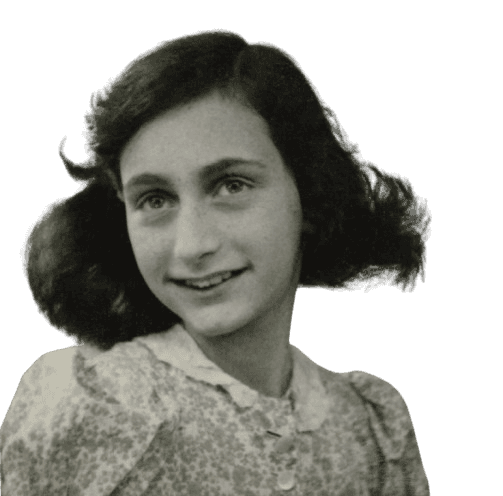Life and achievements
Early life
Anne Frank was born on June 12 June 12, 1929, in Frankfurt am Main, Germany, to Otto and Edith Frank. She had one elder sister, Margot. The Frank family was a Jewish family of liberal orientation who resided in a multiethnic society of Jewish and non-Jewish citizens. The increasing cases of anti-Semitism and the emergence of Adolf Hitler into power made the Franks relocate to Amsterdam in 1933.
Anne and her sister Margot went to school in Amsterdam and made many friends. Anne is a very active and curious person in the story. Otto Frank owned a firm that dealt in pectin, which is used in making jam. At first, it wasn't easy, but the Franks got used to the new life, and Anne enjoyed school and her social life.
The German army invaded the Netherlands in May 1940, and anti-Jewish measures were stepped up soon afterwards. The Frank family was subjected to many limitations and threats. Nevertheless, Anne was able to attend a Jewish Lyceum, a secondary school for Jewish pupils, since Jews were not allowed to participate in non-Jewish schools.
Anne received her renowned diary as a birthday present on June 12, 1942. She used it frequently and wrote about her ideas, visions, and life events. This diary would later grow to be one of the most popular personal narrations of the Holocaust.
When the situation for Jews in Amsterdam deteriorated, the Frank family went into hiding on July 6, 1942, in the Secret Annex behind Otto Frank's office. Anne's childhood and her life up to the time she wrote in her diary give the reader a good idea of what it was like to be a young girl in such a situation.
Legacy
The Diary of Anne Frank, published in 1947, has remained one of the most popular books on the Holocaust. Her writing gives a first-hand and heart-wrenching depiction of her life and the world during one of the worst eras in human history. The diary has been translated into more than 70 languages and made into many plays and movies that have affected millions of people.
The Anne Frank House in Amsterdam, where Anne and her family were in hiding, is now a museum. It stands as a painful representation of the Holocaust and a symbol of the human spirit and its survival. The museum, built to house Anne's story alone, receives over a million people every year, ensuring that the young girl's story is still being told to many people.
Another vital artifact that has contributed to the education of the Holocaust is Anne's diary. It is also taught in schools to raise awareness of the effects of prejudice, hatred, and indifference among the youth. The reader can easily relate to Anne's thoughts, dreams, fears, and perception of the world; thus, the occurring events become more accurate and tangible.
The above points show that Anne Frank is not only remembered for her diary. Many people have been motivated by her life and utterances to stand up against oppression and speak out for people's rights. The Anne Frank Foundation, set up by Otto Frank, the only survivor of the Frank family, is an organization involved in the fight against prejudice and the promotion of tolerance globally. The foundation promotes educational programs and projects that sustain Anne's vision of a more tolerant and humane world.
Thus, the story of Anne Frank is a story of heroism and the need to remember those who perished during the Holocaust. As a result, her words remain relevant and provoke people to act and ponder on the events that have taken place.
Milestone moments
Jun 12, 1929
Anne Frank comes into this world.
Anne Frank was born on June 12 June 12, 1929, in Frankfurt am Main, Germany, to Otto and Edith Frank.
This was the start of a life that would later touch many through her writings, especially the diary that she kept during the Holocaust.
Her childhood was happy in a loving family in Germany; however, the threat of anti-Semitism caused the Franks to move to the Netherlands.
Jun 13, 1933
Emigration to Amsterdam
It was in 1933, when Hitler assumed power, that Anne Frank's family decided to flee Germany and relocate to Amsterdam.
This was a significant event in Anne's life because she spent most of her childhood in Amsterdam and later went into hiding during the Second World War.
The Frank family's life in Amsterdam was initially happy and normal. Otto Frank worked in a business, and the children went to school.
Jun 7, 1942
Going into Hiding
The Frank family hid in the secFrom July 6, 1942, the Annex behind the company's premises was owned by 942.
On July 6, 6sFrank's company premise sided and life in fear, but at the same time, Anne's diary writing was more active than ever.
The Secret Annex, which was a hiding place for four other Jews, became a limited space within which Anne wrote her diary, her hopes, and her daily experiences in hiding.
Aug 4, 1944
Arrest by the GeAugust 4stapo
On August 4, 1944, the Frank familAugust 4y and other occupants of the Secret Annex were betrayed to the Gestapo and arrested.
This led to their deportation to concentration camps; Anne and her sister Margot died in this camp.
The arrest signalled the final chapter in Anne's time in the Franks' hiding place and paved the way for the discovery of her diary after her death.
